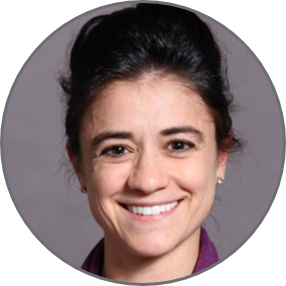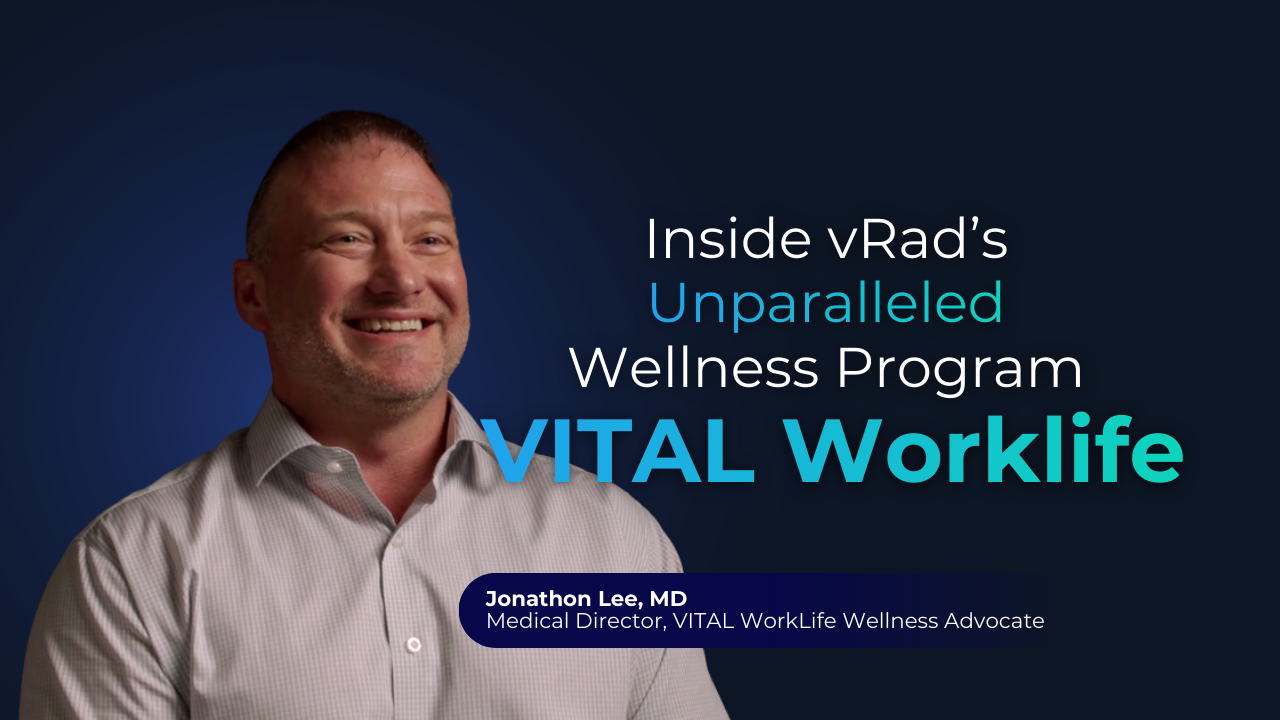Leading the Way to Beat Burnout, vRad Launches Largest Radiologist Wellness Investment Ever
Ask yourself: what is your current practice doing to alleviate burnout? Are they investing in programs to support your professional and personal...

Remote radiologist jobs with flexible schedules, equitable pay, and the most advanced reading platform. Discover teleradiology at vRad.

Radiologist well-being matters. Explore how vRad takes action to prevent burnout with expert-led, confidential support through our partnership with VITAL WorkLife. Helping radiologists thrive.

Visit the vRad Blog for radiologist experiences at vRad, career resources, and more.

vRad provides radiology residents and fellows free radiology education resources for ABR boards, noon lectures, and CME.

Teleradiology services leader since 2001. See how vRad AI is helping deliver faster, higher-quality care for 50,000+ critical patients each year.

Subspecialist care for the women in your community. 48-hour screenings. 1-hour diagnostics. Comprehensive compliance and inspection support.

vRad’s stroke protocol auto-assigns stroke cases to the top of all available radiologists’ worklists, with requirements to be read next.

vRad’s unique teleradiology workflow for trauma studies delivers consistently fast turnaround times—even during periods of high volume.

vRad’s Operations Center is the central hub that ensures imaging studies and communications are handled efficiently and swiftly.

vRad is delivering faster radiology turnaround times for 40,000+ critical patients annually, using four unique strategies, including AI.
.jpg?width=1024&height=576&name=vRad-High-Quality-Patient-Care-1024x576%20(1).jpg)
vRad is developing and using AI to improve radiology quality assurance and reduce medical malpractice risk.

Now you can power your practice with the same fully integrated technology and support ecosystem we use. The vRad Platform.

Since developing and launching our first model in 2015, vRad has been at the forefront of AI in radiology.

Since 2010, vRad Radiology Education has provided high-quality radiology CME. Open to all radiologists, these 15-minute online modules are a convenient way to stay up to date on practical radiology topics.

Join vRad’s annual spring CME conference featuring top speakers and practical radiology topics.

vRad provides radiology residents and fellows free radiology education resources for ABR boards, noon lectures, and CME.

Academically oriented radiologists love practicing at vRad too. Check out the research published by vRad radiologists and team members.

Learn how vRad revolutionized radiology and has been at the forefront of innovation since 2001.

%20(2).jpg?width=1008&height=755&name=Copy%20of%20Mega%20Nav%20Images%202025%20(1008%20x%20755%20px)%20(2).jpg)

Visit the vRad blog for radiologist experiences at vRad, career resources, and more.


Explore our practice’s reading platform, breast imaging program, AI, and more. Plus, hear from vRad radiologists about what it’s like to practice at vRad.

Ready to be part of something meaningful? Explore team member careers at vRad.
4 min read
 Nina Geatrakas, MD
:
February 4, 2022
Nina Geatrakas, MD
:
February 4, 2022
.png)
Burnout is a horrible thing. And while recent research suggests it affects half of all radiologists, women are bearing the brunt – with 56% of female physicians reporting they’re burned out compared to only 41% of their male counterparts.
Why? In addition to the common burnout factors affecting all radiologists, researchers have also concluded that women are disproportionally shouldering the burden of increased demands at home like eldercare, childcare, and family healthcare. This and the lack of flexibility within practices to balance work and life are making it all the more important for women to consider where they work, what impacts their happiness, and the control they have over their own burnout.
I’ve certainly experienced burnout in my own career. I finished my IR fellowship unsure if I even wanted to continue in radiology. My story isn’t unique among female radiologists. Throughout my career, and in my role as Medical Director, I’ve spoken with many colleagues and know that fatigue is almost always the first symptom people notice. As physicians, we know we’re signing up for a difficult job that can be incredibly tiring. But there is also the reward of knowing you have helped take care of people. When that challenge-reward equation is out of balance, however, the exhaustion can become overwhelming.
One factor that contributes to burnout among radiologists is the specialty’s lack of flexibility. We are asked to perform at an incredibly high level – often at an understaffed practice – while facing worklist pressures, unpredictable schedules, and waves of bureaucratic work. And as women, we do this all while spending a disproportionate amount of time on home care, 5 to 10 more hours a week in fact. The pandemic has only exacerbated this difference.
It’s no wonder we are seeing more women impacted by burnout and some female radiologists leaving the specialty altogether. It’s not because they want to, but because their work life isn’t currently adjustable, and their home care responsibilities aren’t escapable. And when female radiologists do leave their jobs, it leads to a widening gender gap in a specialty where women only make up 21% of the workforce.
It does not have to be this way. Burnout may be high among female radiologists, but that is a trend that can be reversed.
When a female radiologist struggles with burnout, the primary issue is often related to her practice and its structure. Finding a practice that works to provide a healthy work-life balance goes a long way toward relieving the fatigue and stress of radiology.
In my situation, teleradiology was the answer. And I know it’s been the answer for others as well.
Why teleradiology? For me, it came down to three primary factors that have significant implications for burnout, especially for women who may be experiencing the additional strains mentioned earlier: Less pressure, fewer distractions and improved representation. Let’s review…
Working in a model that puts fewer demands on productivity can make a substantial difference when it comes to avoiding fatigue and burnout for women. When you constantly feel pressured to do more – stay late or be on call – it’s hard to consistently perform at a high level and balance life outside of your practice. Consider, for example, how caseloads are handled at vRad. While most practices provide radiologists with a full queue of exams that need to be completed that day, causing the specialist to feel pressured and weighed down, the vRad model allows for a shared responsibility among all of our radiologists. That dreaded queue pressure, and the stress that comes with it, becomes a thing of the past. Instead, my time is mine.
The lack of outside distractions and administrative work in teleradiology can also significantly reduce the risk of burnout. At a typical practice, distractions come in many forms—you might have to supervise an injection, track down a referring physician, or field untimely drop-by conversations. This all takes time away from interpreting images and contributes to an already stressed workplace. (It’s no surprise that “too many bureaucratic tasks” was just named the No. 1 reason for burnout among physicians!)
On the flip side, fewer distractions mean more focus on patients and less fatigue from non-clinical work allowing for greater control over my time. With 24/7 IT and operations support, assistance from licensing and credentialing specialists, and other helpful resources, the vRad environment allows for both a focus on patients and a focus on self.
Another factor to consider when it comes to limiting burnout is the makeup of a practice, which can heavily impact the two previous points made above. Are women well-represented? Nationally, female radiologists account for 21% of all practicing radiologists and 13% of radiology leaders. Representation (or in this case, underrepresentation) matters in radiology more than many in the specialty may realize. If you work in a practice where you’re one of the only women, and you don’t see a single woman in a leadership position, it can not only be disheartening, but a sign as to how women are represented and heard across the practice.
I felt so excited when I first joined vRad and noticed how many women I would be working with on a regular basis. Women make up 30% of our total radiologists and 36% of our clinical leaders. That’s well above average and it creates an environment where women are a part of the conversation, making decisions that affect the practice and are valued for the work they do. I don’t have to apologize for my personal life or my perspective.
For any radiologist, it’s important to see yourself represented in your practice so if you do start to experience feelings of burnout, you’ll feel confident that you can speak to someone who will understand your needs and concerns.
I encourage all female radiologists to consider a career in teleradiology. It helps women thrive in ways I never thought possible before I experienced it for myself.
In medicine, where gender equality and burnout both appear to be trending in the wrong direction, vRad is working to change the game completely.
I invite you to give us a try. If you’d like to speak to me directly, please submit your information and mention my name. I’d be happy to share my experience and answer your questions.
Back to Blog
Ask yourself: what is your current practice doing to alleviate burnout? Are they investing in programs to support your professional and personal...
.png)
Burnout has become commonplace among medical professionals, especially radiologists. While increasing caseloads are part of the picture, much of the...

1 min read
Most places I've been are willing to say, you know, wellness is important; you have to take care of yourself to take care of patients. And...
vRad (Virtual Radiologic) is a national radiology practice combining clinical excellence with cutting-edge technology development. Each year, we bring exceptional radiology care to millions of patients and empower healthcare providers with technology-driven solutions.
Non-Clinical Inquiries (Total Free):
800.737.0610
Outside U.S.:
011.1.952.595.1111
3600 Minnesota Drive, Suite 800
Edina, MN 55435